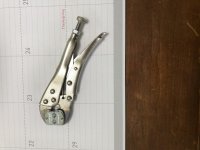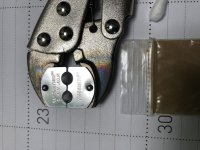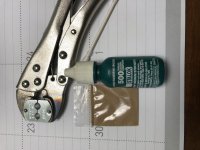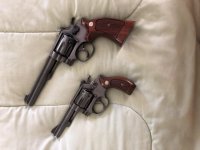I was reading Kuhnhausen and on page 25 is a tool for removing the ejector rod without any damage to the rod. The tool is the "Wessinger tool" named after the inventor George Wessinger. Does anyone use this tool, is it available somewhere to buy? I couldn't find one, but my knowlege of where to search sucks.
You are using an out of date browser. It may not display this or other websites correctly.
You should upgrade or use an alternative browser.
You should upgrade or use an alternative browser.
Ejector rod tool
- Thread starter Igiveup
- Start date
Register to hide this ad
- Joined
- Apr 4, 2006
- Messages
- 19,854
- Reaction score
- 31,833
Don't waste your money. A descent quality Chuck on a Drill Press or portable electric drill will work even better as they are made to chuck cylindrical drill bits quite well - same shape as an ER. Always use the Drill Press or Electric or battery powered tools without power to them so they can not accidentally be turned on. Chuck the ER past the knurling so it does not get damaged. Make the Chuck firmly tight but not "Gorilla tight" to prevent spinning. Always use at least 3 spent cases in the cylinder so the alignment pins don't get broken off. Make sure you know if your revolver has a left or right handed thread!
I have been using my Drill Press with a Jacobs Chuck to disassemble cylinders and ER's for 45 years and doubt any special tool would work better! I have done many of them with no damage and perfect success.
I have been using my Drill Press with a Jacobs Chuck to disassemble cylinders and ER's for 45 years and doubt any special tool would work better! I have done many of them with no damage and perfect success.
Last edited:
Jeppo
Member
austintexas
Member
tool
I bought mine from Dillion
SWCA 892
I bought mine from Dillion
SWCA 892
I'll second the drill chuck suggestion, even a cordless drill with a keyless chuck works perfectly.
I could not get the extractor rod loose on my 396NG not matter what I tried until I used this on it.
I've since done numerous guns, multiple times, with it over the years & its never scratched the rod or slipped.
No matter what tool you use, double, triple, verify the direction you're turning so you won't make matters worse.
.
I could not get the extractor rod loose on my 396NG not matter what I tried until I used this on it.
I've since done numerous guns, multiple times, with it over the years & its never scratched the rod or slipped.
No matter what tool you use, double, triple, verify the direction you're turning so you won't make matters worse.
.
Last edited:
I went to the pawn shop, bought a junk drill 1/2" (a 3/8 would work too) with a decent chuck, removed the chuck and it sets on my bench with the key held hand tight in the jaws. Less than any tool from Midway or Brownells and better.
To remove most of them open them all the way open and there will be a left hand thread machine screw inside going to the shaft, remove it, secure armature and the chuck will screw off. Or be quick and lazy and just use a 4 1/2" .045 grinder disk to cut the shaft right behind the chuck.
I made one of those clamp together around the rod tools, a chuck works better. I only use the clamp on the old big knob rods like on 1917s
To remove most of them open them all the way open and there will be a left hand thread machine screw inside going to the shaft, remove it, secure armature and the chuck will screw off. Or be quick and lazy and just use a 4 1/2" .045 grinder disk to cut the shaft right behind the chuck.
I made one of those clamp together around the rod tools, a chuck works better. I only use the clamp on the old big knob rods like on 1917s
Last edited:
DWalt
Member
If you don"t have a drill chuck, a small square of leather and pliers will work OK. Note that older extractor rods have RH threads, newer ones have LH threads. Always put fired empty cases in the chambers first.
I use a wooden clothespin on the end of the ejector rod and a vise, just tight enough that it doesn't spin in the clothespin. Empty cases in chambers of course. Works very well.
Pretty simple and cheap, just like me.
Pretty simple and cheap, just like me.
I'm a tool hound..love specialty tools
Like said....I'm one of those guys that likes tools even specialty tools made with a specific purpose in mind so I jumped on this S&W specific extractor rod tool from Gunsmither company.
Works on all my S&W's in the stable (I don't have any L Frames)
A teeny dab of Stalok keeps any from shooting loose, and is no problem with next disassembly if you do it often. I don't for normal cleaning, but 22LR seems quite dirty so do a thorough job when residual crud build up.
Like said....I'm one of those guys that likes tools even specialty tools made with a specific purpose in mind so I jumped on this S&W specific extractor rod tool from Gunsmither company.
Works on all my S&W's in the stable (I don't have any L Frames)
A teeny dab of Stalok keeps any from shooting loose, and is no problem with next disassembly if you do it often. I don't for normal cleaning, but 22LR seems quite dirty so do a thorough job when residual crud build up.
Attachments
In my mind, any time metal touches metal, chances of scaring the ejector rod ia big! I fashioned two small pieces of oak in a vise and drill a hole slightly smaller than the rod at the seam. Using spent cases and placing the cylinder in the vise with a thick leather cushion, place the oak pieces around the rod with a thin leather pad. Place a clamp on the wood large enough to use for leverage and unscrew the rod.
I overdid it on extractor rod removal tools. I have the Gunsmither tool, the Ron Power tool, and a small chuck I bought for that purpose.
They all work fine.
You pay your money and you take your choice. But do better than me, actually take a choice rather than buying all three.
I have great difficulty resisting small tools that are intended for, or can be adapted to, firearms use.
They all work fine.
You pay your money and you take your choice. But do better than me, actually take a choice rather than buying all three.
I have great difficulty resisting small tools that are intended for, or can be adapted to, firearms use.
OP
Some excellent ideas. A special tool is nice, and I understand having one, but how many times will I use it at age 75? I am presently trying to remove the extractor on a 10-7 2 inch. I think either the rod or the star is a tad bent, hence my project. Who would have thought of a drill chuck, or even a clothes pin. After I plow snow tomorrow, I will choose one of the simple things and give it a try. Thanks all for your input.
While metal on metal may cause some blue loss, every time you use your ejector that happens. Except for safe queens most guns show some blue wear on the rod. Safe queens don't have their rod come loose.
I would check for burs and damage on a chuck, but the jaws are pretty hard. It is almost always the bit that gets a grrr when a chuck slips. I also tighten the chuck up good and tight when I use it so it does not slip. I have never done a grrr on a rod with a chuck
You could easily smooth up a chuck jaw with a small chain saw file or sand paper on a dowel
Another option is go to the hardware store and buy a piece of brass tubing, Ace has lots in various sizes. Get a piece that it just big enough to slip over your rod, cut of a 1 1/2" and split it with a dremel cutter and place it over rod before you put the chuck on, vise on. etc
I have a couple sheets of thin copper I cut up with scissors to use as shims or slip between work and lath jaws to protect stuff
The hardwood block thing works to, especially with a bit of rosin. I use pieces of oak in my vise to hold barrels when changing them and turn the frame with a frame wrench I have made both aluminum then nylon inserts for.
Take 2 pieces of aluminum brass, steel, oak or what ever, clamp them together and drill a slightly under size hole in the split where they join and your set. If you want something to use over and over first drill thought the pieces from the side so you can bolt the together then drill the clamp hole. If you leave one piece long or weld on a rod you have a handle and basically have made a wrench.
The one I use for rifle barrel is 2 pieces of heavy aluminum I drilled a hole though that clamp between 2 pieces of 3/8" steel bolted together by 4 3/8" bolts on each side. Clamp the reciever in a receiver wrench, heat it up a bit with a torch and then give the barrel wrench handle a good wack. This started life as a Remington 600 in 308, Now it is a 6.5 Creedmoor

Cylinder rods are easy to hold so you can loosen and tighten compared to rifle barrels
I would check for burs and damage on a chuck, but the jaws are pretty hard. It is almost always the bit that gets a grrr when a chuck slips. I also tighten the chuck up good and tight when I use it so it does not slip. I have never done a grrr on a rod with a chuck
You could easily smooth up a chuck jaw with a small chain saw file or sand paper on a dowel
Another option is go to the hardware store and buy a piece of brass tubing, Ace has lots in various sizes. Get a piece that it just big enough to slip over your rod, cut of a 1 1/2" and split it with a dremel cutter and place it over rod before you put the chuck on, vise on. etc
I have a couple sheets of thin copper I cut up with scissors to use as shims or slip between work and lath jaws to protect stuff
The hardwood block thing works to, especially with a bit of rosin. I use pieces of oak in my vise to hold barrels when changing them and turn the frame with a frame wrench I have made both aluminum then nylon inserts for.
Take 2 pieces of aluminum brass, steel, oak or what ever, clamp them together and drill a slightly under size hole in the split where they join and your set. If you want something to use over and over first drill thought the pieces from the side so you can bolt the together then drill the clamp hole. If you leave one piece long or weld on a rod you have a handle and basically have made a wrench.
The one I use for rifle barrel is 2 pieces of heavy aluminum I drilled a hole though that clamp between 2 pieces of 3/8" steel bolted together by 4 3/8" bolts on each side. Clamp the reciever in a receiver wrench, heat it up a bit with a torch and then give the barrel wrench handle a good wack. This started life as a Remington 600 in 308, Now it is a 6.5 Creedmoor

Cylinder rods are easy to hold so you can loosen and tighten compared to rifle barrels
Last edited:
I have this tool as well. Works like a charm!
- Joined
- Apr 4, 2006
- Messages
- 19,854
- Reaction score
- 31,833
Every time this discussion comes up I always suggest a Drill Press or Portable Drill Chuck. If some guys and gals want a "dedicated tool" to do this - then go for it. IMHO nothing works better than a descent quality Jacobs Chuck as that is exactly the shape it was meant to hold and gets a much better purchase on the ER than any of the tools sold at Brownell's, Midway, etc. It is specifically contoured on the inside of the jaws to hold drill bits which is pretty much the exact shape as a ER. Drill bits don't slip if properly inserted and tightened.
I have no way of knowing, however I venture to say most here on this forum have some form of drill press and or portable drill with a half-way descent chuck. Just make sure the electric models are not plugged in and if it's battery powered, take the battery out. You don't want it starting up by accident.
Before buying any special tools, I would suggest trying the "Chuck trick". For the once in a while an ER is removed, special tools are just not needed and IMHO won't work as well anyway! BTW, Used Jacobs Chucks are readily available on ebay and can just be hand held as well. Again, the Chuck will firmly hold an ER better than any of the tools being sold for such purpose. You do not want it slipping or it will mark the ER. I find the key type works better than the hand tightened versions.
OK - so I guess I sound like a broken record - sorry.
I have no way of knowing, however I venture to say most here on this forum have some form of drill press and or portable drill with a half-way descent chuck. Just make sure the electric models are not plugged in and if it's battery powered, take the battery out. You don't want it starting up by accident.
Before buying any special tools, I would suggest trying the "Chuck trick". For the once in a while an ER is removed, special tools are just not needed and IMHO won't work as well anyway! BTW, Used Jacobs Chucks are readily available on ebay and can just be hand held as well. Again, the Chuck will firmly hold an ER better than any of the tools being sold for such purpose. You do not want it slipping or it will mark the ER. I find the key type works better than the hand tightened versions.
OK - so I guess I sound like a broken record - sorry.
Don't care to grab extractor rods with anything made of hardened tool steels. Anything made of aluminum or brass is preferred so as to not risk marring a clients gun.
Easy enough to cobble up a tool if you have a chunk of aluminum, a hacksaw, a drill, some drill bits and a small bolt or two. Oh and a tap set
Not inclined to fabricate? Ron Power's tool works just fine too and never leaves a blemish.
Cheers
Bill
Easy enough to cobble up a tool if you have a chunk of aluminum, a hacksaw, a drill, some drill bits and a small bolt or two. Oh and a tap set
Not inclined to fabricate? Ron Power's tool works just fine too and never leaves a blemish.
Cheers
Bill
Been doing this for a number of years with no problems before I found out there were special tools. Just wrap a relatively soft piece of metal like aluminum or brass around the knurled end of the extractor rod and grip it firmly with regular pliers. Don't go all Hulk on the rod or you might deform it. I also used empty shell casings or snap caps to support the extractor in the cylinder when removing or tightening the extractor rod.


Don't care to grab extractor rods with anything made of hardened tool steels. Anything made of aluminum or brass is preferred so as to not risk marring a clients gun.
Easy enough to cobble up a tool if you have a chunk of aluminum, a hacksaw, a drill, some drill bits and a small bolt or two. Oh and a tap set
Not inclined to fabricate? Ron Power's tool works just fine too and never leaves a blemish.
Cheers
Bill
Wait until something does turn clamped in brass or aluminum. It will leave a smear of gold or silver on the finish that is difficult to remove. Hoe do I know this??? From a matte finished rifle barrel that did just that. Bugger was tight I tell you.
Normally I agree and do not use hardened steel on finished parts, But as someone said a chuck was designed to hold small round shafts firmly. If you turn a rod in a chuck either it was incredibly tight and another tool would have problems with it to but most likely you did not tighten the chuck. While I don't get totally western tightening mine. I am firm on the chuck key. You are not going to collapse a rod with a chuck. Plus I run a fairly big 1/2" chuck and always try to put the rod deep enough in the chuck that the jaws are biting on the portion that is inside the yoke.
Besides if a rod has been used to eject many cases it will have developed some fine lines on it from running in and out of the hole in yoke.
You can dent or mar the finish on something with brass and aluminum anyway. Just hit the corner of something with the corner of a brass hammer. The softer material can over come the hard one if the soft ones surface area is smaller. How did I learn this. LOL
- Joined
- Apr 4, 2006
- Messages
- 19,854
- Reaction score
- 31,833
Wait until something does turn clamped in brass or aluminum. It will leave a smear of gold or silver on the finish that is difficult to remove. Hoe do I know this??? From a matte finished rifle barrel that did just that. Bugger was tight I tell you.
Normally I agree and do not use hardened steel on finished parts, But as someone said a chuck was designed to hold small round shafts firmly. If you turn a rod in a chuck either it was incredibly tight and another tool would have problems with it to but most likely you did not tighten the chuck. While I don't get totally western tightening mine. I am firm on the chuck key. You are not going to collapse a rod with a chuck. Plus I run a fairly big 1/2" chuck and always try to put the rod deep enough in the chuck that the jaws are biting on the portion that is inside the yoke.
Besides if a rod has been used to eject many cases it will have developed some fine lines on it from running in and out of the hole in yoke.
You can dent or mar the finish on something with brass and aluminum anyway. Just hit the corner of something with the corner of a brass hammer. The softer material can over come the hard one if the soft ones surface area is smaller. How did I learn this. LOL
I couldn't agree more!
The jaws of a Jacobs Chuck are precision ground to hold cylindrical shapes (just like an ER) and not slip. A firm tightening will hold it steady and in 45 years I have never scratched, scored or marred an ER.
An ER should never be "gorilla tight" and isn't that tight relative to the strength of a Jacobs Chuck. They loosen quite easily with mild hand turning and there is simply no that much effort needed.
Just a side note about hardnesses........
I used to use (many many years ago) aluminum or coated cleaning rods - I don't anymore. I now use Dewey stainless steel one piece cleaning rods and I will explain why. Coated or soft aluminum cleaning rods work great while they are new, clean, chip, ding and dent free. However, when they start to get scratches, nicked, and worn, they can actually pick up debris that can and sometimes will scratch the inside of a barrel. Stainless steel is harder, much more resistant to dings, nicks, picking up debris etc and if kept clean and smooth will actually not scratch a barrel if kept in good shape. I make sure mine are free from all roughness and defects and once in a long while will go over the length of the rod with ultra fine emery and then with a rag and Flitz. This keeps them ultra smooth and has never done any harm to any gun I have ever cleaned - and believe me....... I have cleaned lots and lots of them! BTW, this was actually told to me from Mr. Dewey himself when I spoke to him many years ago concerning coated rods and chipping. This is his business and that is what he suggested. It made sense to me and I have been doing this since. Hence the soft metal vs hard metal theories. Precision and smoothness trump softness IMO. YMMV.
Similar threads
- Replies
- 1
- Views
- 156
- Replies
- 8
- Views
- 416
- Replies
- 16
- Views
- 1K






